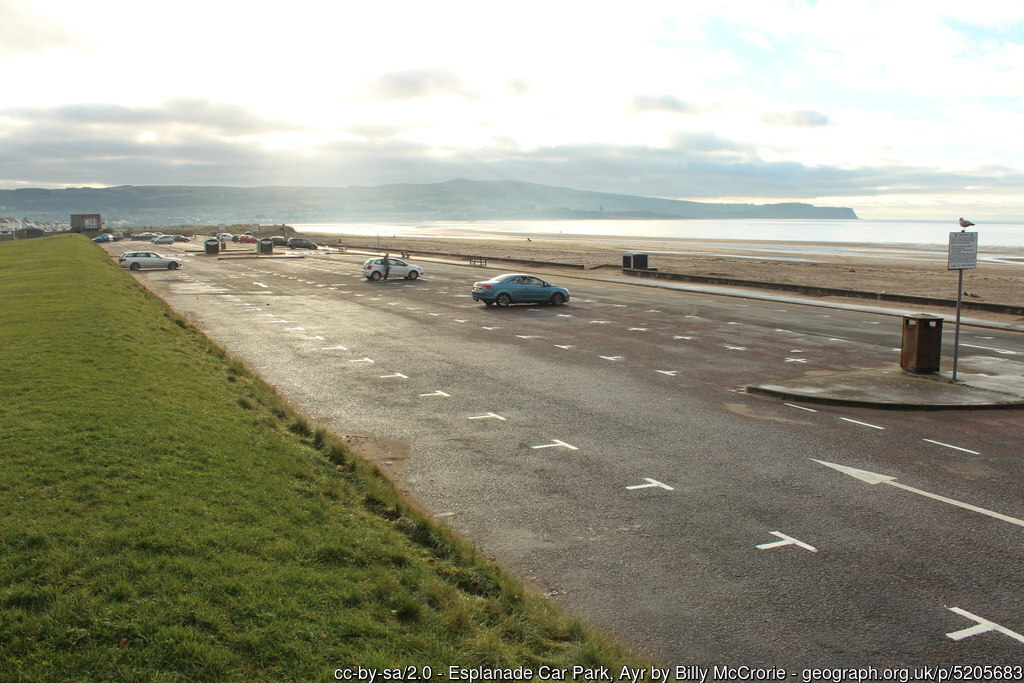Not SlyBob's first visit to Ayr, this, but that memory is of sitting in an indoor shopping centre waiting for some rain to stop.
No such worries today, although it won't be so dry tonight, so it's a first real view of a town that gets lazily lumped into the faded, seaside resort category often with a 'grandeur' thrown in.
Yes, they got the railway early here creating a tourism boom to the beach in the 1840s, well, that and something about a poet or something?
The eye-catching Wallace Tower sits in the middle of the high street and yes, that's Wee Willie Wallace of Braveheart fame.

Scottish independence and self-determination were on the rise in the 1850s and the good folk of Ayr voted for this despite not yet knowing the full story from the film.
Things may be fairly functional along here but it's busy and there's an indoor shopping centre that might be the one from memory.
The high street leads down to a relatively recently developed area that doubles as a Farmer's Market on Saturdays. This is now officially Bob's kind of town, have you seen the queue for the pie stall?

Their livery is hidden meaning their origins are unknown other than they're 'From Scotland', which is now officially Bob's kind of country, like it wasn't already.
The river behind is the River Ayr, naturally, a 40-mile watercourse that starts somewhere to the east that's just about still in Ayrshire.

It's over the bridge and left to the docks for a fair-sized port of no particular interest but further down and facing is the kind of generic, harbourside development that, sorry Ayr, could just about be anywhere.
What couldn't just about be anywhere, however, is what appears to be the highlight of the riverside, an old, nautical hook, whoo-hoo, not shown.
Turning back around to peer at the pies, the steeple isn't that of a Kirk, as they call them round here, rather Ayr Town Hall.

Classic Neoclassical, it's thought you'll agree, just one of many, municipal buildings on show and a fine example of mid-Victorian showing off back when it was boom time.
There's more municipality around the corner, a Primary School of the Grammar variety educating Ayr's elite from a slightly later date.


As for this old Kirk, there we go, it's now a dance studio for those less inclined to be studious next door. Saying that, why not both? Swotty kids can dance too, just not this one.
There's no real reason to highlight random architecture other than it's en route to the seafront, something there's yet to be sight or scent of, so far.
Heading that way brings you to one of Ayr's older features at St. John's Tower or rather what's left of it.

Cromwell ransacked the original church but kept the tower for defensive purposes giving the righteous folk of Ayr a reason to create a new, now Auld, Kirk, there we go again, which can be found back behind the Wallace Tower.
This tower can be found on Bruce Crescent, of the Robert of Bannockburn fame, probably, so no, not that famous Robert so beloved by all of and particularly this part of Scotland.
Robert, Robbie, Rabbie, Rab, Rob or even Robin Burns was born just down the road in Alloway where that's another story.
That means that everywhere south and west of Edinburgh will claim that Scotland's National Poet either passed through, stayed or even lived there, see also Mary Queen of Scots.
And so it is with Ayr, fair enough, and continuing towards the front at Wellington Square, two statues and it was bound to happen sooner rather than later?

It's a surprise, then, to find no sign of the Rabster or Wellington for that matter, neither, but General James George Smith Neill and Sir James Fergusson of Kilkerran. Who? Who indeed...
Neill was a ruthless suppressor of uprisings during his time with the British East India Company and Fergusson was the owner of a Jamaican plantation, hmmm.
Divisive figures both it, erm, could be said, but there's some reparation, perhaps, with a statue of Gandhi inside the Town Hall. It's not knowingly linked with General Neill just a general nod to Mahātmā that was unveiled on his 150th birthday.
The grand construction facing the square is where you would once have found yourself up before the beak or the sheriff as they like to be known up here.

It's another example of ornate if unnecessary columns and all because they were just followers of fashion, Georgian style.
There are fun times to be had in the Golden Disc, a reassuringly old-skool establishment next to Wellington Square with a good line in Go Karts for kiddies, they say.


That means we can't be far from a funfair, surely, but the Ferris wheel looks to be of the temporary variety?
It's only gone and happened again, again, we've accidentally arrived at a festival, Ayr's Pavilion Festival where 12,000 raving loonies will arrive tomorrow to sample the sounds created by someone pushing a button.
Not just someone, several someones, actually, and no, SlyBob hasn't heard of none of 'em, neither.
The family room at the back with two tellies might be essentially windowless but there's no need to negotiate a lift, thanks very much. Built by a Victorian tea baron for his family to enjoy sea views, there is sort of a view of the sea but you'll have to head outside and even then you might have to squint.
It's thankfully free of any loony ravers warming up the night before the Pavilion Festival presses play. No, they will all be seen tomorrow waiting for a bus in Mauchline although how or even if they made it back home after 7 PM isn't known, right commuters?
Mauchline, Mock-Lin, by the way, is home to the National Burns Memorial because he lived briefly on a farm on the outskirts, yeah right.
Ayr has famously, at least it is in Ayr, distanced itself from the beach with a separating green and then nothing more than concrete and parking - thanks Billy - where the sand starts.

That's all down to the toffs whose grand lodgings demanded uninterrupted views to the more-than-serviceable beach, probably.
Most of the south part of town that rubs the coast qualifies in the 'grandeur' category with no hint of the often accompanying 'faded' or for that matter a pub.
The empty esplanade heads south and it's just over a mile to the River Doon where things get rather more dramatic.
The 16th-century ruins of Greenan Castle stand guard over whatever it was that needed guarding and is where the sand is now your path and where wildlife, if you look closely, makes an appearance.


At least it did 13 years earlier and is what happens when you wait long enough for some rain to stop.
Meanwhile, back in the present, The excitement of a random tandoori in a random UK town always delivers, as does Ayr India, seriously, if you give them a call.
The front, as mentioned, is devoid of any development save for a sorry-looking structure straight from the '70s, probably.

Don't be fooled by the exterior, you'll find them upstairs, which is the sister operation to their main one in town. Tucking into a tikka while looking west over water to the Isle of Arran at sunset was indeed, in their words, 'First Class'.


